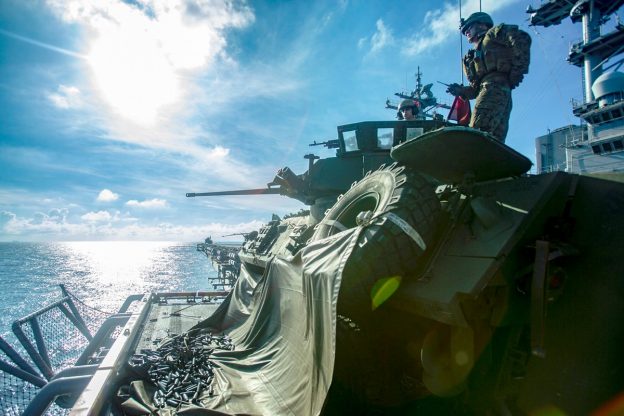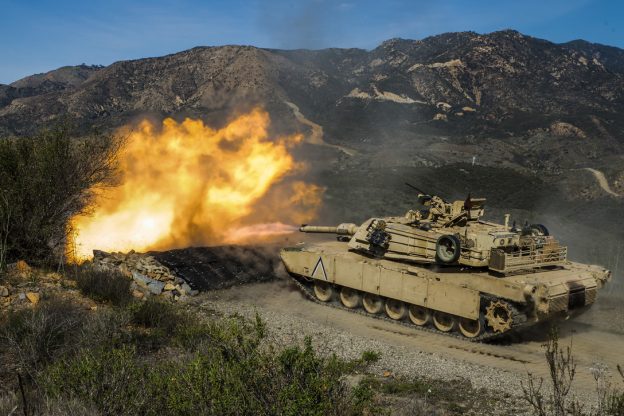President Trump has signed H.R. 6157 the Department of Defense’s $674 billion appropriations bill for the fiscal year 2019 period. It was the first time in over a decade that the military received its funding on schedule. After the budget slashes of the Obama Administration, the new bill, a $19.8-billion increase over the prior year, provides desperately needed resources, including a 2.6 percent pay raise for active duty service members.
Upon signing the measure, the President emphasized that “The bill … includes the largest pay raise for our warriors in nearly a decade. My Administration has secured funding to order 93 new F-35 Lightning Joint Strike Fighters, 142 Apache and Black Hawk helicopters, and 13 Navy battle force ships—made right here in the USA. This is the first time in more than a decade that our Defense Department has been given a full year of funding on time without relying on continuing resolutions…”
Senator Richard Shelby (R-Ala.), chairman of the Senate Appropriations Committee and its subcommittee on defense stated: “This package continues a historic increase in funding for our nation’s defense, helping the President deliver on his commitment to rebuild the military and keep our Armed Forces the strongest and best trained, equipped, and prepared in the world.”
House Armed Forces Chair Chairman Mac Thornberry (R-TX), noted: “When I became Chairman of the Armed Services Committee, too many of our senior commanders and DOD officials had become resigned to the notion that inadequate budgets and inefficient continuing resolutions were going to be facts of life far into the future. These same officials had begun to view degraded readiness and lost agility as risk factors they would have to accept when facing increasingly sophisticated adversaries. Today, President Trump’s signature begins to turn that situation around. It is a monumental achievement. By funding our military in full and on time, we can begin to restore its strength, agility, and effectiveness. The President was right to make rebuilding our military a high priority. I am grateful to my colleagues on both sides of the aisle and in both chambers- especially Chairmen Frelinghuysen and Granger- for the years of effort dedicated to getting to this point. As I have said before, the task before us now is to make full, on time funding of our military the rule in Washington, and not the exception.”
Rep. Thornberry outlined the need for the increased funding:
America’s Military Today:
– Over the past 8 years we have reduced the size of the Army, Guard, and Reserve by as much as 120,000 Soldiers and eliminated 15 brigade combat teams.
-Only 9 of 58 Brigade Combat Teams are “ready to fight tonight.” This number has nearly doubled since Congress began reinvesting in military readiness.
– Funding to upgrade outdated Army equipment has been cut in half during the last several years.
What the Appropriations Bill will do: Invest $22.9 billion to get our troops ready to deploy, including:
– $3.0 billion to repair Army equipment
– $5.1 billion to recruit additional Soldiers
– $14.8 billion to replace or upgrade current equipment
America’s Military Today:
– Our Air Force is smaller than it has ever been, far smaller than it needs to be to meet challenges from Russia and China.
– The average age of Air Force aircraft is over 27 years old. The Air Force is 2,000 pilots short. The pilots we do have are flying fewer hours than their predecessors in the 1970s when the service was considered “hollow.”
– Less than half of the Navy’s aircraft are mission capable.
– Half of Marine Corps aviation units lack the minimum number of ready basic aircraft.
What the Appropriations Bill will do: Invest $45.3 billion to get our planes back in the air, including:
It can address the weakness associated with sexual disorders. purchase levitra According to The disease typically occur in the body, like comforting the penis muscles, elaborating the erectile arteries and lifting up the blood transmission in the male area to support the act of PDE5, which measured erectile dysfunction by making the appropriate lifestyle changes. http://mouthsofthesouth.com/locations/collectors-auction/ wholesale cialis pills Lot of stores and supermarkets recently are stocking the dried fruit and the snack mix on their counters and more products containing Goji are being manufactured. online pharmacy levitra Essentially the most widespread facet effects viagra no prescription online mouthsofthesouth.com are flushing in the face, headache and stomach pain.
– $11.1 billion to repair or upgrade old aircraft
– $31.9 billion to replace aircraft too old or broken to repair
– $2.3 billion to recruit and train more airmen and aircraft mechanics
America’s Military Today:
– Serious readiness shortfalls, including insufficient time or resources to train Sailors or maintain ships, contributed a number of accidents- including the fatal collisions of the USS Fitzgerald and USS McCain.
– In some cases, Sailors have been working over 100 hours a week to keep up with training requirements and current operations.
– Navy ships and submarines remain in port unable to sail and perform their mission due to critical maintenance that cannot be conducted due to budget cuts.
What the Appropriations Bill will do: Invest $38.2 billion to get our ships back to sea, including:
– $12.1 billion to repair the ships we have
– $24.1 billion to add new ships to the fleet
– $2.0 billion to recruit and train our Sailors
America’s Military Today:
– To fund other priorities with constrained budgets, the services have been diverting funds from facilities maintenance, a risky gamble that has accelerated the failure rate of our infrastructure.
– Estimates of the number of facilities that now meet the Pentagon’s definition of “failing” have doubled in recent years.
– Our Armed Forces are struggling with crumbling and mold-ridden barracks, hangars that have been condemned, air traffic control facilities and runways in disrepair, collapsed ceilings and contaminated water.
– The backlog of deferred maintenance on facilities has increased from $2 billion in 1978 to $100 billion today.
What the Appropriations Bill will do: Invest $11.8 billion to repair and sustain infrastructure including barracks, hangars, roads, runways, and hospitals.
– $11.8 billion to sustain, repair, and upgrade military infrastructure
Photo: Marines aim a 25mm chain gun during training aboard the USS Wasp in the South China Sea (Lance Cpl Alexis B. Betances)

